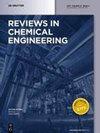微粒流系统湍流调制的关键分析:实验研究综述
IF 6.6
3区 工程技术
Q1 ENGINEERING, CHEMICAL
引用次数: 1
摘要
摘要在多相颗粒系统中,连续相(气体或液体)的湍流由于连续相和悬浮颗粒之间的相互作用而受到调节。这种现象在本质上是不平凡的,即在湍流中添加分散相会使现有的流型复杂化,这取决于颗粒的物理性质,从而导致连续相湍流的增加或衰减。在本研究中,基于从经过充分研究的湍流系统(如通道和管道、自由射流和格栅)获得的可用实验数据,对这一方面进行了全面分析。相关的无量纲参数,如颗粒直径与积分长度标度比、斯托克斯数、颗粒体积分数、颗粒动量数和颗粒雷诺数,已被用于表征所报道的湍流调制行为。讨论了这些常用的无量纲参数在表征湍流调制时的一些局限性,并提出了可能的改进建议。本文章由计算机程序翻译,如有差异,请以英文原文为准。
A critical analysis of turbulence modulation in particulate flow systems: a review of the experimental studies
Abstract In multiphase particulate systems, the turbulence of the continuous phase (gas or liquid) is modulated due to interactions between the continuous phase and the suspended particles. Such phenomena are non-trivial in the essence that addition of a dispersed phase to a turbulent flow complicates the existing flow patterns depending on the physical properties of the particles leading to either augmentation or attenuation of continuous phase turbulence. In the present study, this aspect has been comprehensively analysed based on the available experimental data obtained from the well-studied turbulent flow systems such as channel and pipes, free jets and grids. Relevant non-dimensional parameters such as particle diameter to integral length scale ratio, Stokes number, particle volume fraction, particle momentum number, and particle Reynolds number have been utilised to characterise the reported turbulence modulation behavior. Some limitations of these commonly used dimensionless parameters to characterise turbulence modulation are discussed, and possible improvements are suggested.
求助全文
通过发布文献求助,成功后即可免费获取论文全文。
去求助
来源期刊

Reviews in Chemical Engineering
工程技术-工程:化工
CiteScore
12.30
自引率
0.00%
发文量
37
审稿时长
6 months
期刊介绍:
Reviews in Chemical Engineering publishes authoritative review articles on all aspects of the broad field of chemical engineering and applied chemistry. Its aim is to develop new insights and understanding and to promote interest and research activity in chemical engineering, as well as the application of new developments in these areas. The bimonthly journal publishes peer-reviewed articles by leading chemical engineers, applied scientists and mathematicians. The broad interest today in solutions through chemistry to some of the world’s most challenging problems ensures that Reviews in Chemical Engineering will play a significant role in the growth of the field as a whole.
 求助内容:
求助内容: 应助结果提醒方式:
应助结果提醒方式:


